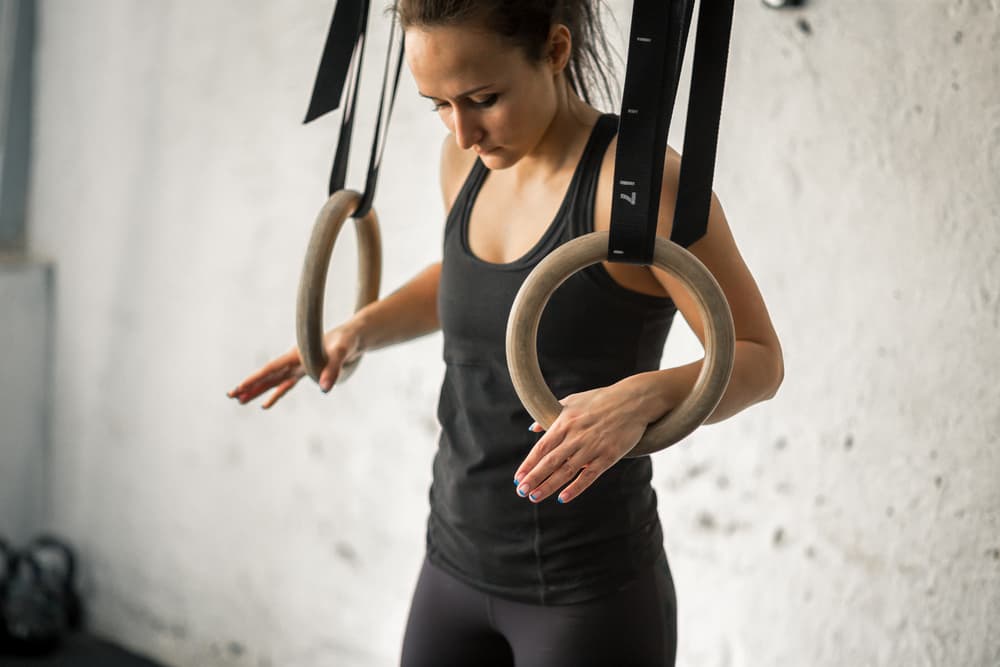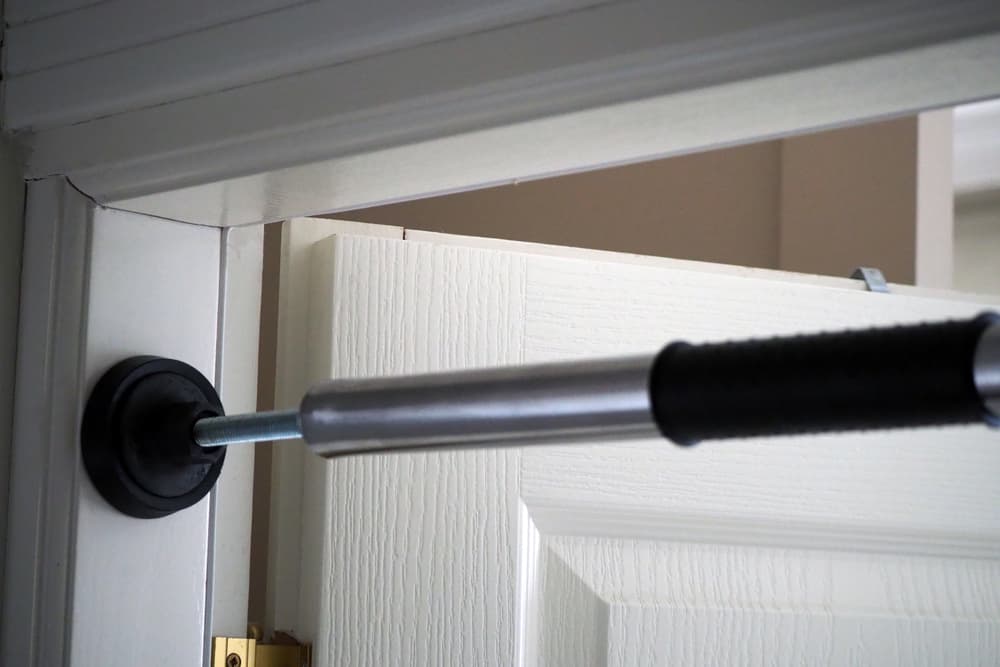Pull-ups and overhead exercises require ample vertical room. And these make pull-up bar installation challenging in low-ceiling home gyms.
Good thing there are several solutions you can do to tackle this problem.
Getting the right pull-up bar type, adjusting your exercise form, or making minor structural changes in your workout space are some quick fixes to try.
Read further to learn more tips and identify which solution will give you the best results.
Tips for Low-Ceiling Pull-Up Bar Workouts
Not enough headspace for executing full pull-ups? Ideally, there should be 41 to 51 cm (16 to 20 inches) clearance when installing a pull-up bar at home.
Depending on your height, this range should give you enough room to do a clean chest-to-bar pull-up without hitting your head on the ceiling.
But no worries if you don’t have this much room in your current space.
You can still do your pull-up sessions with one or two of these recommended solutions.
1. Lower the pull-up bar
If you already have a power rack at home, set its pull-up bar according to the ideal height.
When you do this, you can no longer pull up while keeping your legs straight.
That means you should adjust your pull-up form by bending your legs at the knees or hips to save more height.
2. Use gymnastic rings
Another solution you can do is to attach a pair of gymnastic rings to your existing pull-up bar.
The rings should be at a level that will give you the ideal headroom as you pull yourself up.
This remedy will likely have your body too close to the floor, leaving you no room to bend your legs.
In that case, keep your legs relaxed and straight in front.
Then, pull yourself up using the force from your midsection and upper body.
Aside from your lats, biceps and shoulder muscles, ring pull-ups also engage your core.

3. Try pull-downs instead
If you don’t think the first low-ceiling pull-up bar solutions work for you, why not do pull-downs instead?
Do this by attaching exercise or resistance bands to your pull-up bar. Next, sit down, grab the bands and pull down.
It may be different from the actual pull-up exercise.
However, pull-downs can similarly work your body, particularly your back muscles.
Moreover, this move is a good starter for fitness beginners mastering the pull-up motion or training to be better at pull-ups.
You can also attach fat grip attachments at the ends of your resistance bands.
These barbell accessories can increase resistance while keeping your hands comfortable as you pull the bands down.
They’re excellent for improving your grip strength, too.
Another twist to this low-ceiling pull-up bar solution is to insert a wooden rod through the resistance bands, creating a makeshift lat pull-down machine.
4. Make some structural adjustments
Aside from adjusting your form and exercise equipment, you can also create more headroom in your workout area through the following:
- Adjust your floor thickness. Check if your floor is taking too much ceiling height. If yes, remove your original floor surface. Then, replace it with gym flooring. Note that a thinner gym floor can protect the surface but may have lower noise-damping abilities.
- Check your ceiling. For extra headroom, consider removing it if its sole purpose is to cover up pipes and wires. Have professionals assess the area first and let them make the changes to avoid damaging anything.
- Swap hanging lamps with recessed lighting. Hanging lights protrude from the ceiling, taking up lots of space and height. Add a few centimetres of headroom in your workout area by using flat LED lighting systems instead.
- Use floor standing rather than ceiling fans. Standing fans do not take up ceiling space. They are also moveable. That means you can position them near the door or window to bring fresh air in, which is excellent for a low-ceiling workout room.
I know these suggestions may sound a bit drastic, time-consuming and labour-intensive.
And in some cases, they may not work if you are renting.
However, these long-term solutions are best if you regularly use your pull-up bar or power rack.

5. Install a doorway pull-up bar
If you have a low ceiling at home and still looking for a pull-up bar, consider getting one that you can mount on an open doorway.
Instead of lowering the bar of a bulky power rack, a doorway bar is more space-efficient and portable.
It’s also the cheapest type of pull-up bar that is easy to install – perfect for the budget-conscious.
Remember to mount it on a sturdy door frame and check its maximum weight capacity for safety.
6. Perform pull-up alternatives
One of the benefits of doing standing overhead pull-ups is it involves your entire body, from your legs to your back.
But if your low-ceiling room makes this pull-up bar exercise difficult to do, one option is the seated overhead press.
To do this, push a barbell or pair of dumbbells up while sitting on an adjustable weight bench.
This pull-up variation, of course, lacks the benefit of a full-body exercise.
However, you can maximise your seated overhead press session when you do it without a bench backrest.
This setup encourages your upper body to stay stable while lifting weights.
Check out this list of dumbbell bench press exercises to target other muscle groups, too.
Aside from the seated overhead press, you can also perform the Z-press.
It is also a pull-up variation where you’ll sit flat on the ground while holding a barbell, a pair of dumbbells, or kettlebells at shoulder level.
Next, press the weights up, lock out the weight overhead, descend back to starting position, and repeat.
The Z-press is an advanced variation, though. High levels of stability and flexibility are necessary to pull this off.
7. Do your pull-ups outside
Low ceilings won’t be a problem if you can install your pull-up bar in an open space, like your garden, garage or driveway.
With this solution, you don’t have to worry about your head hitting something.
Plus, ventilation and lighting are free if you exercise outside.
Of course, there are downsides, like inclement weather and curious onlookers.
Also, this option may not work for apartment dwellers and those living in homes without an open area.

Conclusion
Installing at-home pull-up bars in low-ceiling workout areas can be tricky.
However, there are several ways to overcome this issue.
So, don’t hesitate to integrate this exercise into your workout routine and miss out on these pull-up bar benefits.
Hopefully, the tips mentioned work for you and let you maximise your existing space and equipment.
And if you’re still looking for the best pull-up bar for your home gym, I recommend assessing and measuring your area first.
That way, choosing the right pull-up bar that matches your space and ceiling height will be much easier.
Related Questions
1. What are the different types of pull-up bars?
There are four common types of pull-up bars to choose from and match your needs. The doorway type, for example, is excellent for beginners and users who prefer easy installation. Advanced users, on the other hand, can choose between a wall and ceiling-mounted bar. But a free-standing bar is ideal if your space and budget allow it.
2. What are the best pull-up variations?
Pull-ups may be challenging, but there are ways to tweak this exercise to match your fitness capacity. Check out this list of pull-up variations you can try, from beginner to advanced level.
- Foldable vs Traditional Reformers: Which One’s Right for You? - 2 July 2025
- Elliptical Cross Trainer vs Exercise Bike: Which is Better? - 24 June 2025
- How Do the Different Massage Gun Attachments Work? - 23 June 2025
